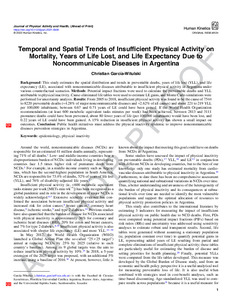Por favor, use este identificador para citar o enlazar este ítem:
https://repositorio.uca.edu.ar/handle/123456789/13883| Título: | Temporal and spatial trends of insufficient physical activity on mortality, years of life lost, and life expectancy due to noncommunicable diseases in argentina | Autor: | García Witulski, Christian Martín | Palabras clave: | EPIDEMIOLOGIA; INACTIVIDAD FISICA; SEDENTARISMO; ENFERMEDADES NO TRANSMISIBLES | Fecha de publicación: | 2022 | Editorial: | Human Kinetics | Cita: | García-Witulski, C.M. Temporal and spatial trends of insufficient physical activity on mortality, years of life lost, and life expectancy due to noncommunicable diseases in argentina [en línea]. Postprint del artículo publicado en: Journal of Physical Activity and Health. 2022, 19 (4). doi: https://doi.org/10.1123/jpah.2021-0508. Disponible en: https://repositorio.uca.edu.ar/handle/123456789/13883 | Proyecto: | Valuación de la mortalidad, años y esperanza de vida perdidos atribuibles a enfermedades no transmisibles debidas a la insuficiente actividad física en Argentina | Resumen: | Abstract: Background: This study estimates the spatial distribution and trends in preventable deaths, years of life lost (YLL), and life expectancy (LE), associated with noncommunicable diseases attributable to insufficient physical activity in Argentina under various counterfactual scenarios. Methods: Potential impact fractions were used to calculate the preventable deaths and YLL attributable to physical inactivity. Cause-eliminated life tables were used to estimate LE gains, and Monte Carlo simulations were performed for uncertainty analysis. Results: From 2005 to 2018, insufficient physical activity was found to be the cause of 7544 to 8220 preventable deaths (≈4.28% of major noncommunicable diseases and ≈2.62% of all causes) and about 221 to 219 YLL per 100,000 inhabitants; between 0.67 and 0.71 years of LE could have been gained. If the World Health Organization recommendations (at least 600 metabolic equivalent tasks minutes per week) had been achieved, between 2813 and 3111 premature deaths could have been prevented, about 80 fewer years of life (per 100,000 inhabitants) would have been lost, and 0.22 years of LE could have been gained. A 15% reduction in insufficient physical activity has shown a small impact on Q outcomes. Conclusion: Public health initiatives must address the physical inactivity epidemic to 1 improve noncommunicable diseases prevention strategies in Argentina. Keywords: epidemiology, physical inactivity. | Cobertura Espacial: | Argentina | URI: | https://repositorio.uca.edu.ar/handle/123456789/13883 | ISSN: | 1543-3080 1543-5474 (online) |
Disciplina: | MEDICINA | DOI: | 10.1123/jpah.2021-0508 | Derechos: | Acceso abierto | Fuente: | Journal of Physical Activity and Health Vol.19, No. 4, 2022 |
| Aparece en las colecciones: | Artículos |
Ficheros en este ítem:
| Fichero | Descripción | Tamaño | Formato | |
|---|---|---|---|---|
| temporal-spatial-trends-insufficient.pdf | 2,05 MB | Adobe PDF |  Visualizar/Abrir |
Visualizaciones de página(s)
130
comprobado en 27-abr-2024
Descarga(s)
65
comprobado en 27-abr-2024
Google ScholarTM
Ver en Google Scholar
Altmetric
Altmetric
Este ítem está sujeto a una Licencia Creative Commons

